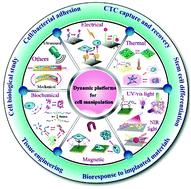Manipulating cell fate: dynamic control of cell behaviors on functional platforms
Abstract
The cell microenvironment choreographs the behaviors of cells through multiple well-controlled signals. For basic biological study and cell-based therapies, it is essential to decipher the complicated cell–matrix interactions, and to develop ways to mimic the dynamic microenvironment so that desired biological functions of cells can be guided. For this, biomaterials with the ability to spatiotemporally impart biochemical and biophysical cues to manipulate cell fate have been developed recently. The dynamic property and programmable features of stimuli-responsive biointerfaces endow them with the outstanding ability to develop advanced biological systems. In this review, we illustrate the recent progress of stimuli-responsive biosystems with a particular emphasis on their explorations for cell-based fundamental studies, disease diagnosis and regenerative therapy. Some basic principles and strategies for the design of dynamic platforms are also discussed in this review. Finally, we conclude with an outlook on current challenges and future of dynamic platforms for cell study and biomedical applications. Overall, we anticipate that this review will boost the development of dynamic and multifunctional biosystems by inspiring interest from various disciplines, including chemistry, materials science, cell biology, nanotechnology, biomedical engineering, as well as clinical research.



 Please wait while we load your content...
Please wait while we load your content...